Research
Research Description
MIMO Communications and Interference Networks
■ Distributed beamforming is challenging but desired as it scales well with the large numbers of base stations and users in the networks. We propose distributed beamforming schemes via alternating direction method of multipliers (ADMM) for MIMO multi-relay interference networks and MIMO multicell interference networks (heterogeneous cloud radio access network, H-CRAN).
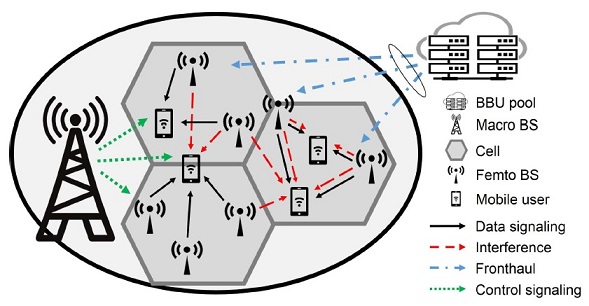
Figure: H-CRAN.
● J.-Y. Lin, R. Y. Chang, C.-H. Lee, H.-W. Tsao, and H.-J. Su, "Multi-Agent Distributed Beamforming with Improper Gaussian Signaling for MIMO Interference Broadcast Channels," IEEE Transactions on Wireless Communications, volume 18, number 1, pages 136-151, January 2019.
● C. M. Yetis and R. Y. Chang, "Distributed Multi-Stream Beamforming in MIMO Multi-Relay Interference Networks," IEEE Access, volume 7, pages 7535-7554, January 2019.
■ Reconfigurable intelligent surfaces (RISs), also known as intelligent reflecting surfaces (IRSs), passive intelligent mirrors (PIMs), and large intelligent surfaces (LISs), have been proposed as a key enabler for next-generation wireless communication. We explore the coexistence of RISs and relays in a multiuser system. The coexistence system is different from the traditional multi-relay system, since there is no interaction between the relays in a multi-relay system but there is interaction between RISs and relays in the coexistence system. The RIS reflects signals transmitted from both the base station (BS) and relays, and there exist tradeoffs in the design of RIS beamforming to cater for both the end users and the relays. We investigate joint beamforming via both model-based and learning-based methods.
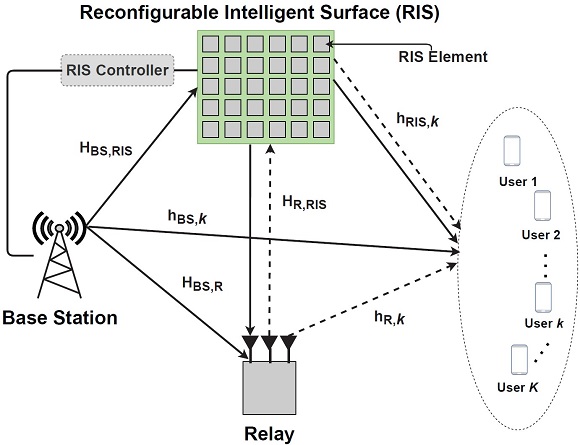
Figure: A coexisting RIS and relay assisted multiuser system.
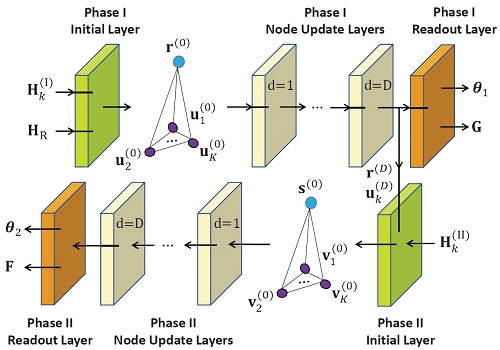
Figure: A graph neural network (GNN) model for joint BS, relay, and RIS beamforming in coexistence systems.
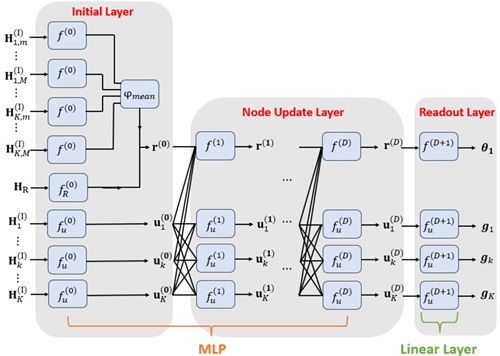
Figure: The architecture of the GNN.
● K.-M. Chen, H.-Y. Chang, R. Y. Chang, and W.-H. Chung, "Deep Unfolded Hybrid Beamforming in Reconfigurable Intelligent Surface Aided mmWave MIMO-OFDM Systems," IEEE Wireless Communications Letters, volume 13, number 4, pages 1118-1122, April 2024.
● K.-L. Chan, F.-T. Chien, and R. Y. Chang, "Beamforming and Load-Balanced User Association in RIS-Aided Systems via Graph Neural Networks," IEEE International Conference on Communications (ICC), June 2024.
● B.-J. Chen, R. Y. Chang, F.-T. Chien, and H. V. Poor, "Graph Neural Network-Based Joint Beamforming for Hybrid Relay and Reconfigurable Intelligent Surface Aided Multiuser Systems," IEEE Wireless Communications Letters, volume 12, number 10, pages 1811-1815, October 2023.
● T.-Y. Kan, R. Y. Chang, F.-T. Chien, B.-J. Chen, and H. V. Poor, "Hybrid Relay and Reconfigurable Intelligent Surface Assisted Multiuser MISO Systems," IEEE Transactions on Vehicular Technology, volume 72, number 6, pages 7653-7668, June 2023.
● T.-Y. Kan, R. Y. Chang, and F.-T. Chien, "Intelligent Reflecting Surfaces and Classical Relays: Coexistence and Co-Design," IEEE Global Communications Conference (GLOBECOM) Workshops, December 2021.
■ Cell-free massive MIMO (CF-mMIMO) has been proposed as a promising technology for beyond fifth-generation (B5G) wireless communications. In a CF-mMIMO network, there is an immense number of access points (APs) each with a single antenna, and users can freely connect to one or multiple APs without cell boundary restrictions. We study joint cooperation clustering (user-AP association) and edge caching (caching at the APs) in CF-mMIMO networks. A joint design is motivated since user-AP association based on channel quality alone could increase network sum rates but may yield low content hit rates and thus extra power consumption associated with retrieving contents from the backbone/backhaul; on the contrary, user-AP association based on AP caching status alone could reduce power consumption related to content retrieval but may not offer good sum rates. We propose single-agent and multi-agent deep reinforcement learning (DRL) approaches to this dynamic joint design problem, which present pros and cons.
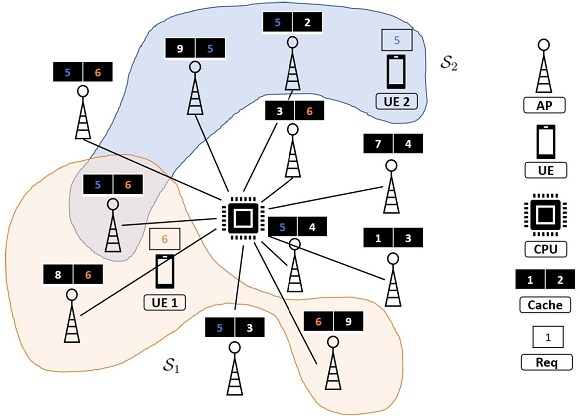
Figure: A cache-enabled cell-free massive MIMO network.
● Y.-C. Chuang, W.-Y. Chiu, R. Y. Chang, and Y.-C. Lai, "Deep Reinforcement Learning for Energy Efficiency Maximization in Cache-Enabled Cell-Free Massive MIMO Networks: Single- and Multi-Agent Approaches," IEEE Transactions on Vehicular Technology, volume 72, number 8, pages 10826-10839, August 2023.
● R. Y. Chang, S.-F. Han, and F.-T. Chien, "Reinforcement Learning-Based Joint Cooperation Clustering and Content Caching in Cell-Free Massive MIMO Networks," IEEE Vehicular Technology Conference (VTC), September 2021.
■ The degrees of freedom (DoF) of MIMO interference networks represents the number of interference-free signaling dimensions in the network. In other words, it can be regarded as the maximum number of decodable data streams in noise-free and interference-free environments. Interference alignment (IA) is based on the idea of aligning multiple interfering signals into a subspace of provably smallest dimension such that the dimension of the signal subspace is increased as much as possible for the multiuser environment, i.e., the DoF is maximized.

Figure: DoF allocation in two-cell MIMO networks.
We consider a two-cell uplink cochannel multiple-input multiple-output (MIMO) network with users sequentially arriving to the network. We study the problem of sequential base station (BS) selection for the users, with the selection criterion based on the degrees of freedom (DoF) available for the new arriving user. We find that different sequential BS selections affect individual and network performance in terms of the individual and network sum DoF as well as the number of admissible users in the network. We also study DoF-based mode selection for device-to-device (D2D) communications.
● H.-J. Chou and R. Y. Chang, "Joint Mode Selection and Interference Management in Device-to-Device Communications Underlaid MIMO Cellular Networks," IEEE Transactions on Wireless Communications, volume 16, number 2, pages 1120-1134, February 2017.
● H.-J. Chou, R. Y. Chang, and J.-M. Wu, "Degrees-of-Freedom-Based Sequential Base-Station Selection in Cochannel MIMO Networks," IEEE Transactions on Vehicular Technology, volume 65, number 2, pages 953-959, February 2016.
● H.-J. Chou, C.-C. Chou, J.-M. Wu, and R. Y. Chang, "On the Achievable Degrees of Freedom of Two-Cell Multiuser MIMO Interference Networks," IEEE Transactions on Communications, volume 62, number 8, pages 2880-2893, August 2014.
■ Base station cooperation (BSC), also known as network MIMO, is a multi-antenna signal processing technique that enables several nearby BSs to jointly serve multiple MSs. We proposed a distributed channel selection scheme for realizing network MIMO under time-varying wireless channel. The channel allocation problem is formulated as a noncooperative game and studied in a game-theoretic framework.
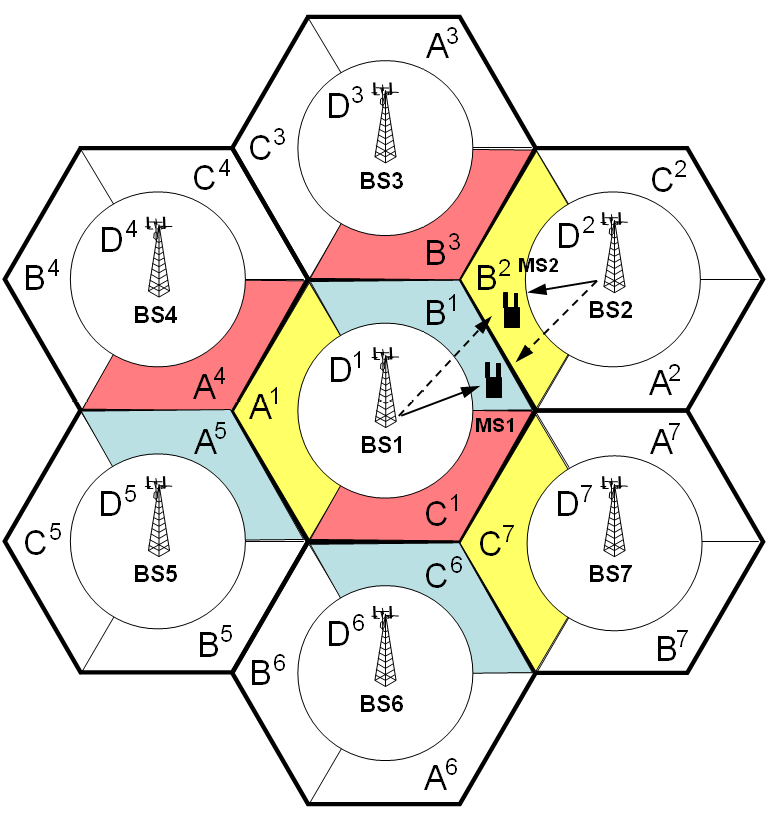
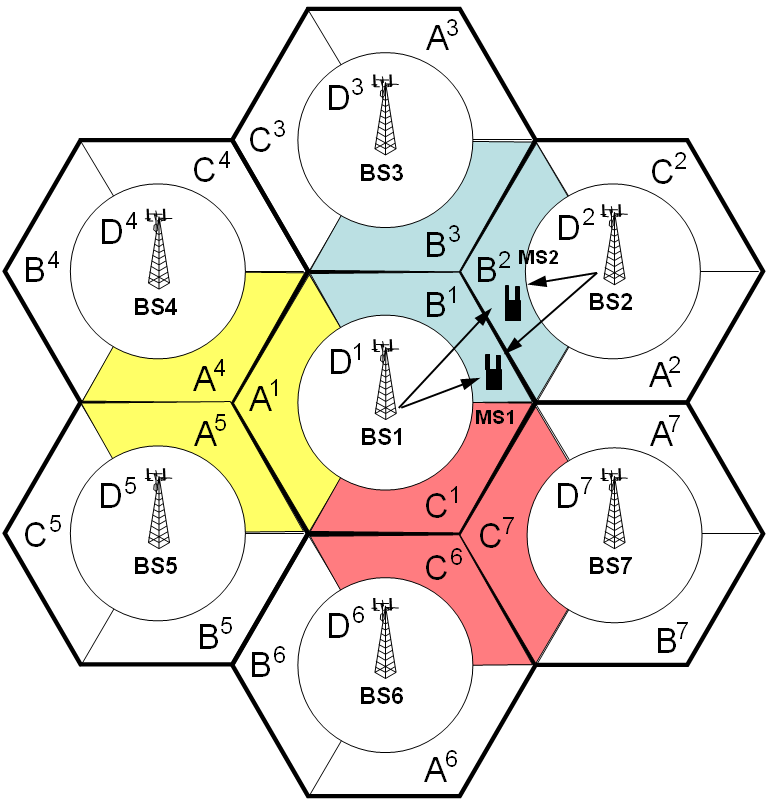
Figure: Cellular network and resource management schemes: intercell
interference coordination (ICIC) (left) and base station cooperation (BSC)
(right).
● L.-C. Tseng, F.-T. Chien, R. Y. Chang, W.-H. Chung, C.Y. Huang, and A. Marzouki, "Distributed Channel Assignment for Network MIMO: Game-Theoretic Formulation and Stochastic Learning," Wireless Networks, volume 21, number 4, pages 1211-1226, May 2015.
■ The tree representation of the MIMO detection problem is illuminating for the development, interpretation, and classification of various detection methods. We develop enhanced MIMO detection schemes based on various tree search algorithms innovatively applied to the detection tree.
● T.-W. Mo, R. Y. Chang, and T.-Y. Kan, "DeepMCTS: Deep Reinforcement Learning Assisted Monte Carlo Tree Search for MIMO Detection," IEEE Vehicular Technology Conference (VTC), June 2022.
● R. Y. Chang, W.-H. Chung, and S.-J. Lin, "A* Algorithm Inspired Memory-Efficient Detection for MIMO Systems," IEEE Wireless Communications Letters, volume 1, number 5, pages 508-511, October 2012.
● R. Y. Chang, S.-J. Lin, and W.-H. Chung, "Efficient Implementation of the MIMO Sphere Detector: Architecture and Complexity Analysis," IEEE Transactions on Vehicular Technology, volume 61, number 7, pages 3289-3294, September 2012.
● R. Y. Chang and W.-H. Chung, "Best-First Tree Search with Probabilistic Node Ordering for MIMO Detection: Generalization and Performance-Complexity Tradeoff," IEEE Transactions on Wireless Communications, volume 11, number 2, pages 780-789, February 2012.
Energy Harvesting Communications
■ With the advances of energy harvesting wireless communication technology, there is a potential for simultaneous wireless information and energy transfer in multiuser environments. Interference among different users is utilized as a source for wireless energy harvesting. The proposed efficient power recycling and usage scheme provides a promising green solution for future communication.
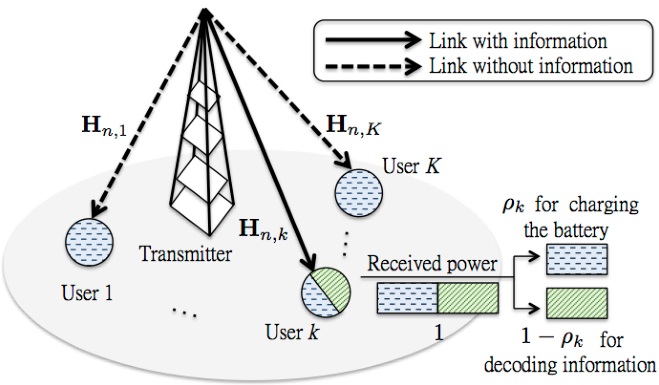
Figure: A multiuser multichannel wireless system supporting simultaneous wireless information and energy transfer.
We study joint subchannel allocation, power allocation, and beamforming for simultaneous wireless information and power transfer (SWIPT) in multiuser downlink orthogonal frequency-division multiple access (OFDMA) systems. We formulate a multi-objective optimization (MOO) problem where the objectives are to maximize both the information rate and the harvested power for all users in the system.
● H.-J. Chou, R. Y. Chang, and J.-M. Wu, "Multi-Objective Optimization of Wireless Information and Power Transfer in Multiuser OFDMA Systems," IEEE Global Communications Conference (GLOBECOM), December 2015.
■ We present a novel receiver architecture design incorporating an interplay between the information receiver and the energy harvester to enhance the performance of the practical SWIPT receiver. In particular, the energy level of the received signal monitored at the energy harvester is fed back to the information receiver to assist information decoding at the information receiver. Based on this architecture, we propose a new relay protocol called energy-assisted decode-and-forward (EDF), which is an enhancement to the DF relay protocol for SWIPT networks.
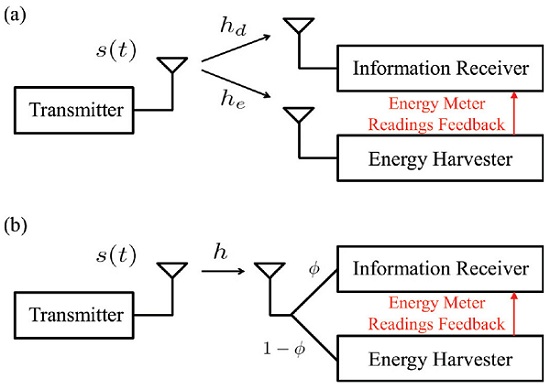
Figure: The proposed SWIPT architecture with energy meter readings feedback. (a) Separated receiver architecture. (b) Co-located receiver architecture with power splitting.
● D. K. Verma, R. Y. Chang, and F.-T. Chien, "Energy-Assisted Decode-and-Forward for Energy Harvesting Cooperative Cognitive Networks," IEEE Transactions on Cognitive Communications and Networking, volume 3, number 3, pages 328-342, September 2017.
● C.-H. Chang, R. Y. Chang, and F.-T. Chien, "Energy-Assisted Information Detection for Simultaneous Wireless Information and Power Transfer: Performance Analysis and Case Studies," IEEE Transactions on Signal and Information Processing over Networks, volume 2, number 2, pages 149-159, June 2016.
Relay-Assisted Communications
■ Relay-assisted communications, where one or several intermediate relays
help forward the source's information
toward the destination, is a promising
technique to enhance the coverage and reliability of wireless
communication. We analytically quantify the
diversity gain of a noncoherent distributed space-frequency coded (SFC)
wireless two-hop relay system with decode-and-forward relaying.
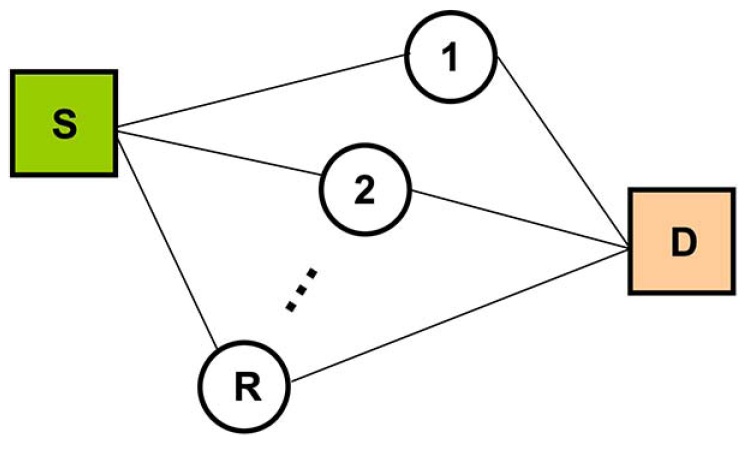
Figure: A two-hop wireless relay system with a single source, R relays, and a single destination.
● S.-E. Chiu, F.-T. Chien, and R. Y. Chang, "On the Diversity of Noncoherent Distributed Space-Frequency Coded Relay Systems with Relay Censoring," IEEE Transactions on Communications, volume 62, number 10, pages 3491-3503, October 2014.
■ In a wireless two-way relay network, two users out of direct communication range exchange information through a single relay (e.g., two laptops communicate through the access point). Various protocols have been studied for this scenario. In the conventional decode-and-forward (DF) relaying, each user's message is sent to its destination in two hops and four time slots are needed to complete information exchange. If the network coding (NC) technique is used in conjunction with DF relaying, the relay after decoding the two users' messages broadcasts in one time slot a combined signal (e.g., XOR operation of the two users' messages), and three time slots are needed. The time efficiency and the throughput can be further improved by a protocol called denoise-and-forward (DNF) relaying adopting physical-layer network coding (PNC), introduced in 2006, which requires two time slots. In DNF relaying, the two users transmit concurrently to the relay in one time slot (the multiple access (MA) phase) and the relay receives an interfered signal. Without decoding the two users' messages, which is supposedly infeasible, the relay simply applies a many-to-one mapping technique (denoising) and broadcasts a denoised message in the next time slot (the broadcast (BC) phase).

Figure: Message exchange in a wireless two-way relay network with
physical-layer network coding.
The two-way relay network can be generalized to a multi-way relay network where each user's message is intended for all other users and full information exchange is desired through a single relay. We generalize the key idea of PNC from two-user to multiuser scenarios by proposing communication protocols that facilitate full information exchange in a multi-way relay network, as well as investigate the decoding strategies and error performances of different communication protocols for the multi-way relay network.
● R. Y. Chang, S.-J. Lin, and W.-H. Chung, "Transmission Protocol Design for Binary Physical Network Coded Multi-Way Relay Networks," IEEE Vehicular Technology Conference (VTC), May 2014.
● R. Y. Chang, S.-J. Lin, and W.-H. Chung, "Joint-Denoise-and-Forward Protocol for Multi-Way Relay Networks," Asia-Pacific Signal and Information Processing Association Annual Summit and Conference (APSIPA ASC), October 2013.
● R. Y. Chang, S.-J. Lin, and W.-H. Chung, "Symbol and Bit Mapping Optimization for Physical-Layer Network Coding with Pulse Amplitude Modulation," IEEE Transactions on Wireless Communications, volume 12, number 8, pages 3956-3967, August 2013.
■ Physical-layer security introduces the concept of establishing secure wireless communications through the inherent randomness and location-specific properties of the wireless channel in the physical layer rather than the conventional cryptographic methods in the application layer. We study the information-theoretic secrecy rates of wireless two-way relay systems.
● C.-H. Chang, R. Y. Chang, and Y.-C. Huang, "A Comparative Analysis of Secrecy Rates of Wireless Two-Way Relay Systems," IEEE Global Communications Conference (GLOBECOM), December 2015.
Machine-to-Machine (M2M) Communications
■ The machine-to-machine (M2M) relay implements a data aggregation scheme for M2M communications. The relay (data aggregator) has limited radio resources and thus only a subset of machines are selected for transmission. Missing data from nonselected machines are reconstructed at the data aggregator by exploiting data correlation.
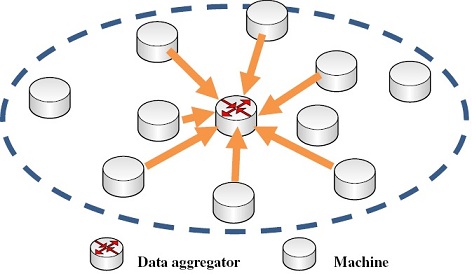
Figure: Data aggregation in M2M communications.
In M2M communication, a massive number of machine devices may transmit simultaneously in response to an event occurring in the system. Supporting massive device transmission while maintaining low congestion and low access delay is a challenging problem. We propose a new transmission control scheme based on slotted ALOHA, with a practical consideration of partial information available at the data aggregator about the system.
● C.-H. Chang and R. Y. Chang, "Design and Analysis of Multichannel Slotted ALOHA for Machine-to-Machine Communication," IEEE Global Communications Conference (GLOBECOM), December 2015.
● C.-H. Chang, R. Y. Chang, and H.-Y. Hsieh, "High-Fidelity Energy-Efficient Machine-to-Machine Communication," IEEE International Symposium on Personal, Indoor, and Mobile Radio Communications (PIMRC), September 2014.
Wireless-Empowered Machine Learning
■ Federated learning (FL) is a cost-efficient and privacy-preserving distributed learning framework. In a standard FL framework, edge devices compute local model updates using their datasets. The updated model weights are transmitted to a parameter server ("uplink"), where the global model is updated by computing the arithmetic mean of received weights. The updated global weights are then distributed to the edge devices ("downlink") to further update their local models. The learning iteration continues until convergence is achieved in both the global and local models. To enhance the communication efficiency during FL model aggregation, over-the-air computation has been introduced, which exploits the superposition property of wireless channels to facilitate concurrent local weight communication and global model computation. We investigate FL with model heterogeneity, RIS-enabled over-the-air FL, satellite-enabled FL, etc.
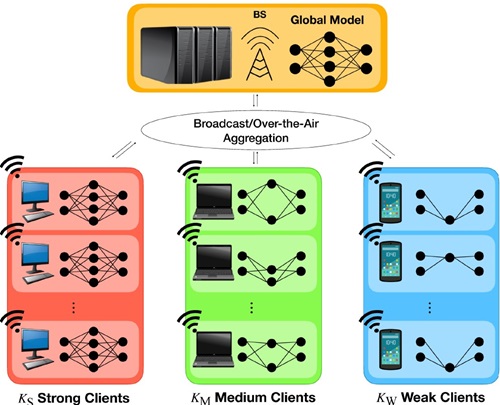
Figure: A wireless-enabled FL system with model heterogeneity.
Machine Learning for IoT Applications
■ We consider many important enabling technologies and applications in the future Internet of Things (IoT) paradigm, such as wireless indoor localization, indoor people counting, energy management for smart homes, etc. We propose machine learning based methods using wireless signatures such as channel state information (CSI) as features. We develop visual analytics techniques to understand the working mechanism of deep neural networks (DNNs), convolutional neural networks (CNNs), generative adversarial networks (GANs), etc. for wireless indoor localization.

Figure: Experiments for device-free wireless indoor localization.

Figure: The 2D visualization of (a) the raw CSI samples, (b) the last DNN hidden layer activations before training (with random initializations), and (c) the last DNN hidden layer activations after training. For each location, the training samples are shown with a darker shade to distinguish from the testing samples with a lighter shade of the same color. The silhouette scores (calculated for the training samples only) for (a)-(c) are 0.22, 0.09, and 0.66, respectively.
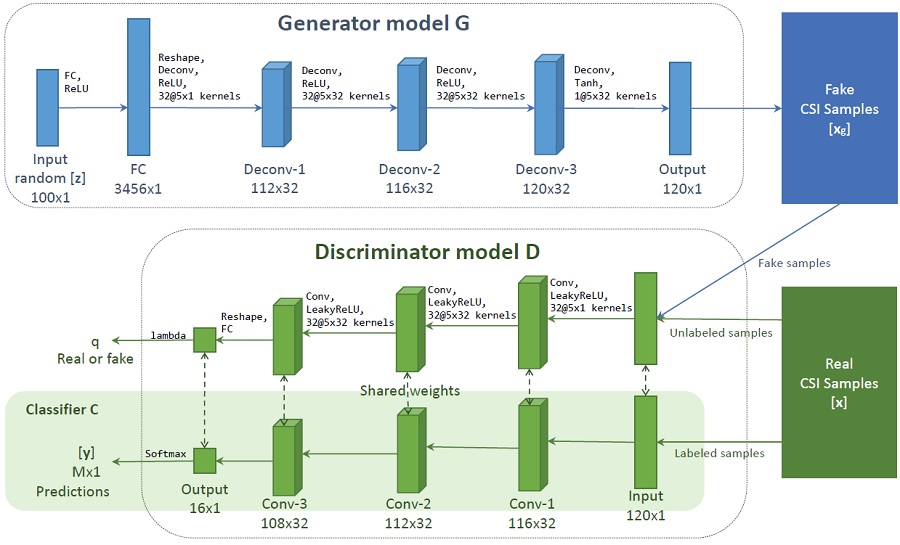
Figure: Deep convolutional generative adversarial network (DCGAN) model for semi-supervised device-free fingerprinting indoor localization.

Figure: (a)–(d) Fake CSI samples generated by G of DCGAN in four different epochs of training, i.e., epoch 0 (initialization), epoch 1, epoch 10, and epoch 100 (end of training), respectively, and (e) real CSI samples, for location p2. (f)–(j) plot the same for location p8.
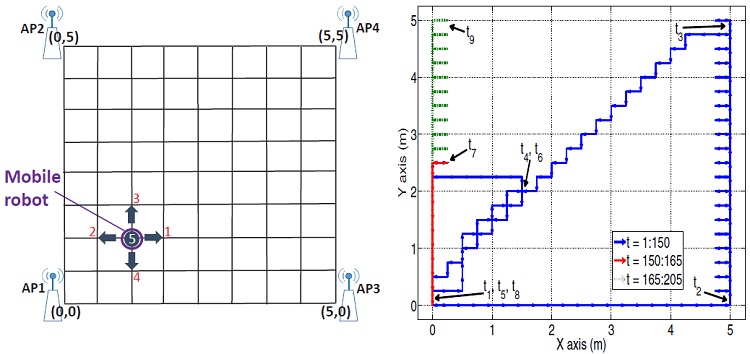
Figure: A mobile micro-robot explores an unknown area to collect data to construct an energy harvesting map of the environment (left) and the traces of robotic exploration (right).

Figure: The federated meta-learning framework for device-free multi-environment indoor localization.
● B.-J. Chen, R. Y. Chang, and H. V. Poor, "Fast-Adapting Environment-Agnostic Device-Free Indoor Localization via Federated Meta-Learning," IEEE International Conference on Communications (ICC), May 2023.
● B.-J. Chen and R. Y. Chang, "Few-Shot Transfer Learning for Device-Free Fingerprinting Indoor Localization," IEEE International Conference on Communications (ICC), May 2022.
● K. M. Chen and R. Y. Chang, "A Comparative Study of Deep-Learning-Based Semi-Supervised Device-Free Indoor Localization," IEEE Global Communications Conference (GLOBECOM), December 2021.
● K. M. Chen and R. Y. Chang, "Semi-Supervised Learning with GANs for Device-Free Fingerprinting Indoor Localization," IEEE Global Communications Conference (GLOBECOM), December 2020.
● K. M. Chen, R. Y. Chang, and S.-J. Liu, "Interpreting Convolutional Neural Networks for Device-Free Wi-Fi Fingerprinting Indoor Localization via Information Visualization," IEEE Access, volume 7, pages 172156-172166, December 2019.
● S.-J. Liu, R. Y. Chang, and F.-T. Chien, "Analysis and Visualization of Deep Neural Networks in Device-Free Wi-Fi Indoor Localization," IEEE Access, volume 7, pages 69379-69392, June 2019.
● R. Y. Chang, S.-J. Liu, and Y.-K. Cheng, "Device-Free Indoor Localization Using Wi-Fi Channel State Information for Internet of Things," IEEE Global Communications Conference (GLOBECOM), December 2018.
● Y.-K. Cheng and R. Y. Chang, "Device-Free Indoor People Counting Using Wi-Fi Channel State Information for Internet of Things," IEEE Global Communications Conference (GLOBECOM), December 2017.
● Y.-K. Cheng and R. Y. Chang, "Self-Sustainable Robotic Environment Discovery for Energy Harvesting Internet of Things," IEEE Vehicular Technology Conference (VTC), June 2017.
● Y.-K. Cheng, R. Y. Chang, and L.-J. Chen, "A Comparative Study of Machine-Learning Indoor Localization Using FM and DVB-T Signals in Real Testbed Environments," IEEE Vehicular Technology Conference (VTC), June 2017.
● Y.-K. Cheng, H.-J. Chou, and R. Y. Chang, "Machine-Learning Indoor Localization with Access Point Selection and Signal Strength Reconstruction," IEEE Vehicular Technology Conference (VTC), May 2016.
● Y.-K. Cheng, H.-J. Chou, and R. Y. Chang, "High-Precision Wireless Indoor Localization via Weight-Learning Ensemble Support Vector Regression," IEEE Vehicular Technology Conference (VTC), September 2015.
E-Health Communications
and Assistive Technologies
■ Wireless technology, such as short-range wireless systems, has found
many healthcare applications such as blood pressure or body temperature
monitoring, audio/video transmission, etc. This research focuses on
enhancing the features of wireless technology, such as low energy
consumption and small transceiver size, from an application-driven
perspective.
People with hearing loss often experience more difficulty communicating over the cell phone than over the landline and face-to-face communication. This is because of the interference between the cell phone and the hearing-assisting device, the heightened noise due to mobility and environment, and the limited phone bandwidth. This research focuses on improving hearing-impaired people's experience with the cell phone.
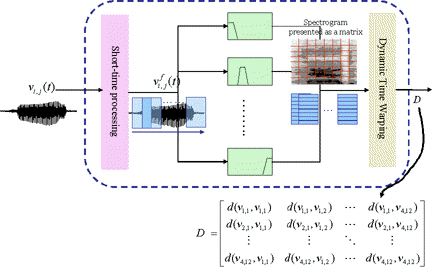
Figure: Modeling of speech perception in cochlear implants.
The frequency modulation (FM) system allows a person with hearing loss to receive the voice signals of the speaker directly transmitted to the receiver worn by the person with hearing loss. This is similar to the FM radio. The FM system can enhance the signal-to-noise ratio (SNR) by about 12-20 dB, greatly reducing the influence of background noise on the perception of voice messages. The FM system is widely used in educational settings such as classrooms to help children with hearing loss to listen to the teacher with less difficulty.
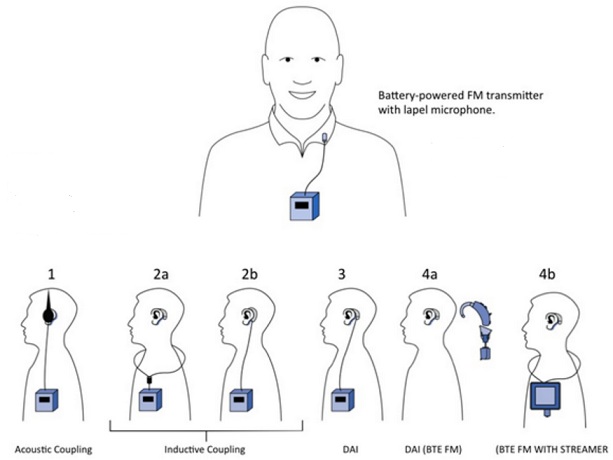
Figure: The FM system.
We propose a new implementation of FM systems based on smartphones using wireless technologies ("SmartHear"), which offers better accessibility, affordability, and customization and extension potentials, and is stigma-free. The proposed system (video1, video2) is included as an assistive technology by Resource Portal of Assistive Technology (衛福部輔具中心,link) and covered by the local media, magazine, and book (link1, link2, link3, link4). The SmartHear 2.0 (or 智慧聽 2.0, if the smartphone's language setting is Chinese) mobile app is available for download for free on Google Play store.
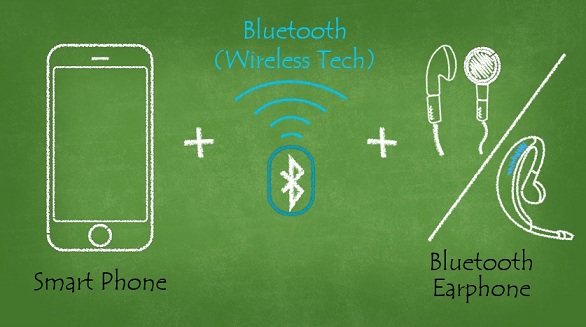
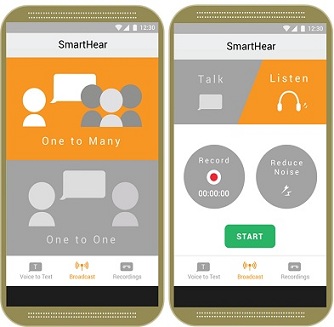
Figure: The proposed hearing assistive system and the mobile application's intuitive user interface.

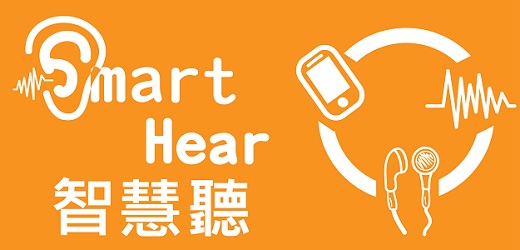
Figure: SmartHear's logo.
● Y.-C. Lin, Y.-H. Lai, H.-W. Chang, Y. Tsao, Y. Chang, and R. Y. Chang, "SmartHear: A Smartphone-Based Remote Microphone Hearing Assistive System Using Wireless Technologies," IEEE Systems Journal, volume 12, number 1, pages 20-29, March 2018.
● A. Chern, Y.-H. Lai, Y. Chang, Y. Tsao, R. Y. Chang, and H.-W. Chang, "A Smartphone-Based Multi-Functional Hearing Assistive System to Facilitate Speech Recognition in the Classroom," IEEE Access, volume 5, pages 10339-10351, June 2017.
● Y.-T. Liu, Y. Tsao, and R. Y. Chang, "Nonnegative Matrix Factorization-Based Frequency Lowering Technology for Mandarin-Speaking Hearing Aid Users," IEEE International Conference on Acoustics, Speech and Signal Processing (ICASSP), March 2016.
● Y.-T. Liu, R. Y. Chang, Y. Tsao, and Y. Chang, "A New Frequency Lowering Technique for Mandarin-Speaking Hearing Aid Users," IEEE Global Conference on Signal and Information Processing (GlobalSIP), December 2015.
External Research Projects
【Development and Applications of Multiuser Low Earth Orbit (LEO) Satellite Communication / 多用戶低軌衛星通訊技術開發及應用】Hon Hai Research Institute 鴻海精密工業股份有限公司-鴻海研究院 (2023-2024) (PI)
【Beyond the Surface: Design and Applications of Reconfigurable Intelligent Surface (RIS) Aided Communication / 不只是表面功夫:可重構智能表面輔助通訊之設計與應用】National Science and Technology Council, Taiwan (2023-2026) (PI)
【AI-Enabled Hybrid Reconfigurable Intelligent Surface (RIS) and Relay Systems for 6G Communications】MediaTek Advanced Research Center (2022-2025) (Co-PI)
【Distributed Beamforming and Power Allocation in Wireless-Powered Dense IoT Networks / 使用無線供電技術之密集物聯網的分散式波束成型與功率分配】Subsidy for Short-Term Research Abroad for Technologists, Ministry of Science and Technology, Taiwan 科技部補助科學與技術人員國外短期研究 (2021-2022) (PI)
【GIDA: Green, Intelligent, Decentralized, and Autonomous D2D/M2M Communications for Smart IoT / GIDA: 實現智慧物聯網的節能、智能、分散、自主裝置間/機器間通訊】Ministry of Science and Technology, Taiwan (2020-2023) (PI)
【Green Smart Living Enabler: Wireless Energy Harvesting Internet of Things / 綠能與智能生活的推手:使用無線能量採集之物聯網技術】Outstanding Young Scholar Award, Ministry of Science and Technology, Taiwan 科技部優秀年輕學者研究計畫 (2017-2020) (PI)
【Green Radio, Great Potential: Simultaneous Information and Power Transfer in Multiuser Wireless Networks / 綠能無線,潛能無限:多用戶無線網路之同步訊息與電力傳輸】Outstanding Young Scholar Award, Ministry of Science and Technology, Taiwan 科技部優秀年輕學者研究計畫 (2015-2017) (PI)
【Implementing Remote Microphone Hearing Assistance Technology on Smart Phone Platform (2/2) / 遠端麥克風助聽技術於智慧型手機平台之實現 (2/2)】Research Projects on Assistive Technologies for Individuals with Disabilities, Ministry of Science and Technology, Taiwan 科技部身心障礙輔助科技技術發展研究專案計畫 (2015-2016) (Co-PI)
【Implementing Remote Microphone Hearing Assistance Technology on Smart Phone Platform (1/2) / 遠端麥克風助聽技術於智慧型手機平台之實現 (1/2)】Research Projects on Assistive Technologies for Individuals with Disabilities, Ministry of Science and Technology, Taiwan 科技部身心障礙輔助科技技術發展研究專案計畫 (2014-2015) (Co-PI)
【Communication Protocol Design and Analysis for Physical-Layer Network Coded Wireless Relay Networks / 使用物理層網路編碼之中繼站無線網路的通訊協定設計與分析】Ministry of Science and Technology, Taiwan (2014-2015) (PI)
【Study of Space Shift Keying Modulation for MIMO Systems and Its Unequal Error Protection Applications / 多重輸出入系統之空間偏移調變及其不對等錯誤保護之研究】National Science Council, Taiwan (2013-2014) (PI)